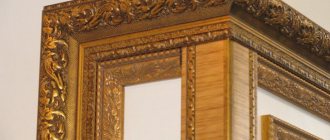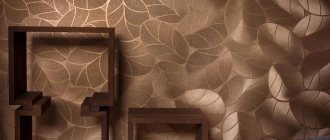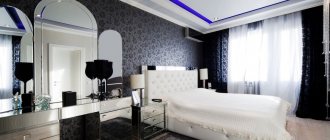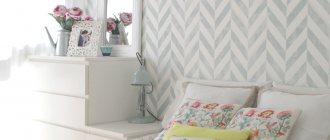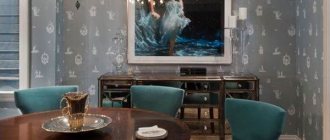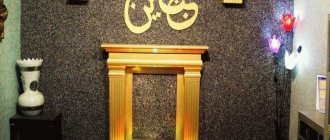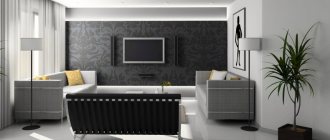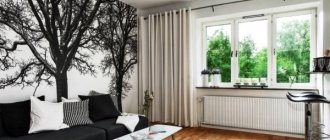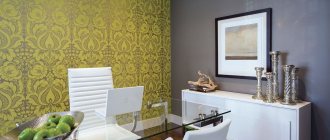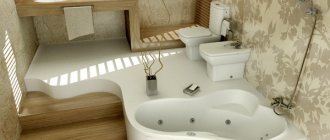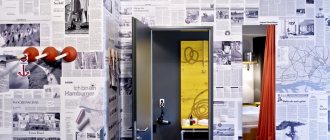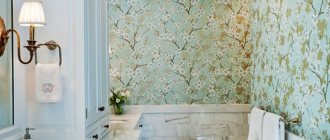As you know, everything new is well forgotten old. So in the first half of the last century, newspapers instead of wallpaper were widespread, because not everyone could afford to buy expensive finishing materials. Later, paper wallpaper ceased to be of any value, but newspapers did not disappear from the walls, but simply “hid” under decorative canvases, as they began to be used as a substrate.
In our time, newspapers are again in the public eye. Of course, now this is not due to a shortage of material and its high cost, but to the desire to decorate the interior in an original and extravagant way. Moreover, in order to decorate a room in this way, it is not even necessary to subscribe to newspapers, since ready-made wallpaper for newspapers has appeared on the market.
Wall covered with newspapers
Next, we will look at the features of this finish and how this coating can be applied to the walls.
Using newspapers under wallpaper
It must be said that using newspapers under wallpaper is a completely justified decision and in some cases it won’t hurt even in our time. Therefore, first of all, you should say a few words about why you should glue newspapers under the wallpaper.
The explanation is very simple - the paper backing allows you not to putty or prime the walls. This is especially true for rooms with wooden partitions. The fact is that wet newsprint swells greatly, and after drying it stretches and thereby hides minor defects in the base.
Newspaper wallpaper in retro style
Thus, this technology will save time, for example, if you are doing repairs in a country house yourself.
Why is this necessary?
You can use such a coating to decorate your home for various reasons. First of all, it's unusual. Nowadays, many are trying to add individuality to their apartments, and this material will make this idea come true. No one can be surprised now even with the most modern, expensive and beautiful wallpaper on the walls, and newspapers will look very interesting and unusual.
The second reason for using such decor may be its graphic nature. When creating contrasting interiors in black and white, the best solution is difficult to find. Even the presence of color illustrations will not spoil the picture if there are not too many of them. On the contrary, several colored areas on the walls will look quite harmonious and will slightly “dilute” the overall monotony of the design.
Banal savings can also be one of the reasons - in some cases, the cost of finishing material will be reduced to zero, except for glue. However, using old paper is far from the best option. It is better to pay attention to ready-made wallpaper for walls, designed “to resemble a newspaper”. They differ from standard products only in their external design, and the gluing process is no different. At the same time, you can find very affordable options.
Newspapers in the interior
Modern style
Wallpaper from newspapers in the interior can look really very interesting. However, in this case, the overall design style of the room must correspond to this decision. In particular, the main design details must be modern and original.
It is not necessary to decorate all the walls of the room with this material. To achieve the desired effect, it is often enough to decorate only one wall with newspapers, the one that catches your eye the most. At the same time, the “newspaper” theme can be continued in other interior details.
For example, you can make a lampshade from newspapers, cover doors with newspapers, etc. As for furniture, it should be simple, modern and concise. It would be even better if it also had an imitation newspaper printed on it, although this is not easy to find.
Newspaper-themed furniture
However, it is important to maintain a sense of proportion, otherwise the room will be very “dappled” and lose its attractiveness. As a rule, designers add a classic play of black and white to such an interior, as a result of which the room looks most harmonious. At the same time, you can make several accents with bright colors.
The advantage of such an interior is not only its nice and unusual appearance, but also the low cost of repairs, since you do not have to spend money on expensive finishing materials for the walls.
Sofa decorated with newspapers
Retro style
Often, wallpaper in the form of newspapers is used in a retro style. In this case, you can cover only part of the wall with newspapers. Moreover, the material in this case will carry a semantic load.
Therefore, it is necessary to find the press of those times. In the absence of one, you can select clippings on the Internet and print them. It is advisable to use newsprint for this.
Advice! When decorating an interior in a retro style, it is advisable to use several decorative items that evoke associations with old times. This could be, for example, a tube black and white TV or radio.
Puttying walls
Functional interior details
The functional use of magazines in the interior is exactly the case when the phrase “coffee table” takes on a double meaning. Yes, yes, your bedside table can now consist entirely of magazines, all you need to do is fold them in an impressive stack and secure them at the top and bottom.
This option will be most appropriate for those who absolutely do not want to part with their collection of magazines and will often “pull out” part of the table to read at night. If magazines do not represent such value for you, then improvised furniture from them can be much more varied. You can create a table with chairs, and even a sofa: for this it will be more practical to use some kind of base - you cannot predict the build of your future guests. However, it is possible to use only magazines, however, in this case it is better to secure them “tightly”.
Whatever option you choose, it will undoubtedly add dynamism to your interior, because now you will literally have ideas and smart thoughts in the air.
Photo: likeforyou.ru, tridevici.com, interiers-foto.ru, vk.com, abcgreatpix.com, designea.ru, magicaldecor.ru, blockstroi.ru, lady-ladik.livejournal.com, subscription.ru, cityspb. ru, mirtesen.ru, styldoma.ru
Add to favorites2
- Tags
- budget ideas
- newspapers and magazines
- Decor element
- wall decoration
budget ideas, newspapers and magazines, decor element, wall decoration
Pasting newspapers instead of wallpaper
Of course, to decorate a room in this way, the easiest way is to buy ready-made newspaper-style wallpaper. However, as practice shows, they are quite rare on sale, and besides, they do not look so authentic. Therefore, you can use an old newspaper file as wallpaper.
In this case, the instructions for finishing the walls are as follows:
- First of all, as with wallpapering, you need to prepare the base - remove the old coating and eliminate defects . If the base is in poor condition, then the surface must be completely puttied.
- Then the base is treated with a primer for walls . This procedure allows you to improve the adhesion between materials, strengthen old plaster, and also prevent the development of mold, mildew and other microorganisms under the wallpaper. To achieve the best effect, the wall must be primed twice.
- Next, wallpaper glue is applied to the wall..
In the photo - sticking a newspaper on the wall
- Then apply a newspaper to the area treated with glue and carefully smooth it with a roller so as not to tear the thin paper.
- The next sheet is glued overlapping in the same way..
- After the walls have dried, the coating should be secured with varnish, otherwise it will be fragile . The varnish is applied in a thin layer using a roller. Depending on the type of composition, the varnish can make the paper yellow or, conversely, make it completely white.
Advice! It is best to use a water-based varnish as a finishing coat. It dries quickly and has no odor.
Opening walls with white varnish
This completes the process of gluing the walls. The coating turned out to be durable and monolithic, like real wallpaper. If suddenly the result disappoints you, then it’s not a shame to rip off the finishing, since it required much less investment than repairs using traditional materials.
Decorative elements
It may seem that in terms of decor you won’t be able to do much with newspapers, however, this is absolutely not the case. Due to their monochrome nature, they can be successfully combined with many details, so you can create almost anything from them. These can be all kinds of boxes, caskets, garlands and table decorations. A romantic theme will look very interesting, especially if you use political publications. Newspapers can be used both as part of the decoration and as the main element - it all depends on the density of the material, and, of course, on the dexterity of your hands.
As for magazines, they are more suitable for finishing something. An excellent solution would be to frame the mirror using “tubes” of multi-colored magazines: here you will immediately kill two birds with one stone – you will create an interesting design and use the lion’s share of your waste paper.
In addition, in the resulting “windows” you can store various small items or hide savings for a rainy day.
Cooking technique
Making liquid wallpaper is a fairly simple task and consists of several stages:
1. You need to take 200 g of paper (the quantity can be calculated depending on the required volume), cut into strips or torn into small pieces, then placed in a bucket and filled with 1.25 liters of warm water.
Related article: How to visually increase space with wallpaper: expanding a narrow room
Paper or newspaper is cut and filled with water
2. To completely soak and soak in water, the composition should be infused for about an hour.
3. Then, using a drill or mixer, the solution must be stirred and crushed until smooth.
Using a mixer, bring to a homogeneous mass.
4. Add 2 caps of paint of the selected color to paint it in the desired tone.
Add paint and glue
5. After that, 20 g of PVA glue is poured into the solution and everything is thoroughly mixed again.
The mixture is thoroughly mixed
6. At the last stage, 200 g of gypsum is added. The material sets quickly, so immediately after this you should begin applying the solution.
Sparkles or colored fibers can also be added to the liquid, which will add even more originality to the finish.
On video: liquid wallpaper from newspapers.
Photo
Next in the photo you can see how you can paste over the walls, and how newspapers pasted instead of wallpaper will look in the interior.
Advantages and disadvantages of coating
Like everything else in the world, this type of inexpensive finishing has its own pros and cons.
Decor advantages:
- paper plaster is the cheapest wall decor;
- excellent thermal insulation properties;
- environmentally friendly;
- porous structure absorbs noise;
- high elasticity (does not create cracks during shrinkage);
- do not burn, extinguishing when ignited;
- vapor permeable;
- mask wall defects;
- The walls are warm to the touch.
Disadvantage: takes a long time to dry
Why do craftsmen glue paper to walls before wallpaper?
Wallpapering is a rather complex and time-consuming process. Before gluing, the surface must be prepared: leveled, primed. Some old-school masters advise sticking paper under the wallpaper, or, as they did before, newspaper. You will find out why this is needed in this article.
Advantages of the paper layer
Pasting paper under wallpaper is rather a relic of the past. This was done in the Soviet Union, when the walls were not smooth, and good wallpaper glue was very difficult to find. Back then, newspapers were glued to the clay walls. Newspapers even stuck to a simple soap solution.
What advantages can you get from this:
- will level the wall, smooth out bumps and holes;
- it is as if the clay surface is “sealed”, the wall will not crumble;
- The wallpaper will stick to such a surface more reliably and firmly.
Since in the Soviet Union they didn’t bother much with repairs, this paper base served as a kind of primer.
Why newspaper
- It is thin, so it adheres well to any surface.
- You can choose any glue, the newspaper sheet will still sit firmly, even on ordinary PVA.
- The newspaper format is large, A1, which means the surface of the walls will quickly be covered.
- It dries quickly, so you don’t have to wait a lot of time before hanging the main wallpaper.
- Wallpaper sticks to this layer quickly, evenly and firmly. It will take some effort to tear them off.
Paste
Since buying wallpaper paste in the Soviet country was an unaffordable luxury, people cooked it on their stove. To do this, we bought a pack of starch for a few kopecks and put it on low heat. Why spend money on glue when it’s so easy to make at home.
This solution was cooked in large enamel pots or basins. It was called klester. And, although such a cluster did not quite meet all the requirements, the main thing is that it is cheap and cheerful. And the newspaper stuck to such a paste perfectly. Well, it was good to glue the paper wallpaper onto the newspaper.
But all these are relics of the past. Modern hardware stores are teeming with various types of putties and primers, which can be purchased at a fairly competitive price. They are much more convenient to use and more profitable in terms of reliability. They will perfectly level any wall surface and prepare it for wallpaper.
Important! Nowadays, wallpaper has become much heavier, and therefore requires more careful surface preparation than before.
Today you rarely see such a repair that there is a paper layer.
Modern wallpaper coverings are divided into:
- deep penetration;
- more diluted PVA glue;
- antifungal coatings;
- perchlorovinyl;
- glyphthalic;
- alkyd;
- acrylic.
Also, for more reliable adhesion, you can apply a solution of bleach.
In a modern interior, you can see a newspaper on the walls only as a design element. Indeed, newspaper walls are now coming back into fashion. Only nothing sticks on top of them anymore. Yes, and newspapers are not simple ones, but special, thick wallpaper, with a printed image. Looks retro, very impressive.
Now it’s clear why modern craftsmen use a paper layer in wallpapering only as a decorative element. And for preparing walls, there are more modern methods.
Working with liquid wallpaper
Before finishing with any decorative materials, preparation of the wall/ceiling surfaces is required. Such preparation consists of removing the old coating (if there was one), filling large grooves and cracks. Putty is necessary to reduce the consumption of liquid wallpaper. Apply a layer of primer to the prepared walls. A purchased primer or one made by yourself will do. It is easy to prepare the primer yourself as follows: dilute 200 grams of laundry or baby soap in 10 liters of hot water. Stir the solution periodically. After the soap has dissolved, the primer is ready. After applying the primer, after 4 to 5 hours of drying, begin applying liquid wallpaper.
Advice: If after applying the coating you find any remaining wallpaper, do not rush to throw it away. Spread in a thin layer on plastic wrap, dry and put in a bag.
Use them later.
Before finishing with any decorative materials, preparation of the wall/ceiling surfaces is required.
See alsoThe main stages of decorating and setting up a wedding table
Master class on making liquid wallpaper with your own hands
Working with this material does not require professional training. Covering walls with liquid wallpaper does not cause discomfort and anyone can handle it. Wallpapering is quite fun. You can even involve children in the decorating process. The material is hypoallergenic, non-toxic. It is easy to work with, as it is very plastic (When finished, it resembles softened plasticine). If there is a desire to make any adjustments during the work, the applied layer can be easily removed if you spray it with water from a spray bottle. The layer gets wet and is carefully removed with a spatula.
Decorating walls in an apartment with your own hands using liquid wallpaper
Manufacturing stages:
- Prepare a plastic bowl for mixing wallpaper.
- Pour the prepared paper into the basin.
- Pour in warm water. Leave the mixture to swell for about 3-5 hours.
- Mix well
Large room with walls decorated with liquid wallpaper - Add color and wallpaper glue to the mixture. Add the dye carefully, bringing the solution to the desired color. Mix well. Transfer the solution to a bag and leave it for another 12 hours to swell.
- Gypsum is added immediately before application.
- Add warm water if the solution seems insufficiently elastic.
Pour in warm water. Leave the mixture to swell for about 3-5 hours.
See alsoAll about ventilation in the bathroom and toilet
Preparation of materials and tools
Making liquid wallpaper with your own hands is quite simple. To work you will need the following components:
- newspapers;
- clean warm water, which will serve as the basis for the future composition;
- tinting pigment for water-based paints (color selected according to individual preferences);
- PVA glue for strength and elasticity of the solution;
- alabaster is predominantly of high quality.
The following tools should be prepared:
- a drill or screwdriver with a special mixer attachment for grinding paper to the desired consistency;
- bucket or other container for solution;
- putty knife.
